
"For No Reason at All in C" is a 1927 jazz instrumental by Bix Beiderbecke, Frankie Trumbauer, and Eddie Lang. [1] It was released as a 78 rpm single in 1927 on OKeh Records as by "Tram, Bix and Eddie (In Their Three Piece Band)". [2] [3]

"For No Reason at All in C" is a 1927 jazz instrumental by Bix Beiderbecke, Frankie Trumbauer, and Eddie Lang. [1] It was released as a 78 rpm single in 1927 on OKeh Records as by "Tram, Bix and Eddie (In Their Three Piece Band)". [2] [3]
Bix Beiderbecke plays piano and cornet, Frankie Trumbauer plays a C melody saxophone, and Eddie Lang is on acoustic guitar. [4] The piece was composed by Beiderbecke and Trumbauer and recorded in New York on May 13, 1927. [5] Bix Beiderbecke and Frankie Trumbauer had earlier worked together as members of the Jean Goldkette Orchestra. The recording was originally released as a 78 rpm single on OKeh 40871 (matrix 81085), and subsequently on Columbia 35667, and in the UK on Parlophone R3419. The flip side of the OKeh single was "Trumbology". [6]
The work is sometimes erroneously credited to George W. Meyer, Sam M. Lewis, and Joe Young. They composed a song entitled "For No Reason At All" in 1921. The Bix Beiderbecke/Frankie Trumbauer piece is a different work.
In "The Birth of the Cool 1927", Len Weinstock showed that Bix Beiderbecke's collaborations with Frankie Trumbauer resulted in the emergence of "cool jazz": [7]
Who was the father of Cool Jazz? Miles Davis? Lester Young? Stan Getz? Gerry Mulligan? The answer, is none of the above. Cool Jazz has its roots as early as 1927 in the wonderful collaborations of cornetist Bix Beiderbecke and C-melody saxman Frank (Tram) Trumbauer! Bix and Tram were closely associated as early as 1925 and developed a tight musical rapport. They both used a linear, relaxed and lyrical style and were the first to offer an alternative to the searing, passionate and extroverted music that characterized the Jazz Age. ...
This really constituted the birth of Cool Jazz. The most important recordings of these groups include Singin' the Blues, Way Down Yonder in New Orleans, I'm Coming Virginia, For No Reason At All in C, Wringin' and Twistin' and Bix's legendary piano solo In a Mist. Somewhat hotter but still very much laid back were Clarinet Marmalade, Ostrich Walk, and Riverboat Shuffle.
These works were not simply recorded and then forgotten, to be rediscovered as an oddity at some later date. These records caused an immediate sensation in the Jazz community and sent a shockwave through Jazz history that can still be felt today.
The composition has also been analyzed as one of the first uses in jazz of contrafact techniques, using the chord progressions of another song to create a new song, which became popular in Be-Bop. The song uses chord progressions of the 1926 song "I'd Climb the Highest Mountain (If I Knew I'd Find You)" written by Lew Brown and Sidney Clare.
Marty Grosz and His Honoras Causa Jazz Band recorded it on the album Hooray for Bix! . Scott Robinson recorded "For No Reason at All in C" on his 2000 album Melody from the Sky. The Bix Beiderbecke Fabulous band performed it at the 2003 Bix 100 Project in the Netherlands in the Jazz Club Delft in March, 2003. The project was initiated and directed by multi-instrumentalist Ad Houtepen. The instrumental was also recorded by composer Julio Remersaro (piano & cornet) during a performance at the AMIA Auditorium on August 4, 2013 in Buenos Aires, Argentina. The piece was also performed in concert in 2003 by a band that included Mark Shane on piano, Howard Alden on guitar, and Dan Levinson, Jerry Dodgion, and Scott Robinson on C-melody saxophone at the JVC Jazz Festival at the Hunter College Danny Kaye Playhouse in an arrangement by Dan Levinson during the Bix Beiderbecke centennial. [8] Hal Smith's Swing Central released a version of the piece in 2017 on the album Windy City Swing.
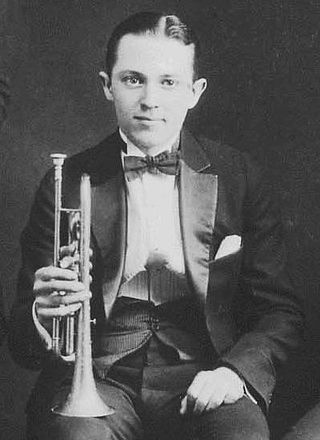
Leon Bismark "Bix" Beiderbecke was an American jazz cornetist, pianist and composer.

Hoagland Howard Carmichael was an American musician, composer, songwriter, actor and lawyer. Carmichael was one of the most successful Tin Pan Alley songwriters of the 1930s, and was among the first singer-songwriters in the age of mass media to utilize new communication technologies such as television, microphones, and sound recordings.

Eddie Lang was an American musician who is credited as the father of jazz guitar. During the 1920s, he gave the guitar a prominence it previously lacked as a solo instrument, as part of a band or orchestra, and as accompaniment for vocalists. He recorded duets with guitarists Lonnie Johnson and Carl Kress and jazz violinist Joe Venuti, and played rhythm guitar in the Paul Whiteman Orchestra and was the favoured accompanist of Bing Crosby.

Giuseppe "Joe" Venuti was an American jazz musician and pioneer jazz violinist.

Orie Frank Trumbauer was an American jazz saxophonist of the 1920s and 1930s. His main instrument was the C melody saxophone, a now-uncommon instrument between an alto and tenor saxophone in size and pitch. He also played alto saxophone, bassoon, clarinet and several other instruments.
Reuben Bloom was an American songwriter, pianist, arranger, band leader, recording artist, vocalist, and author.

"Mississippi Mud" is a 1927 song written by Harry Barris, first sung by Bing Crosby as a member of Paul Whiteman's Rhythm Boys. Its musical composition entered the public domain on January 1, 2023.
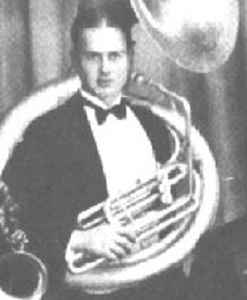
Wilford F. Min Leibrook was an American jazz tubist, bass saxophonist and double bassist.

"Riverboat Shuffle" is a popular song composed by Hoagy Carmichael, Irving Mills, and Dick Voynow. Lyrics were later added by Carmichael and Mitchell Parish.

"In a Mist" is a 1927 composition for piano by Bix Beiderbecke.
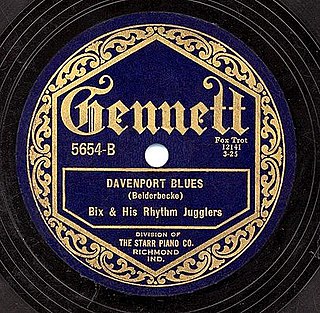
Davenport Blues is a 1925 jazz composition written and recorded by Bix Beiderbecke and released as a Gennett 78. The song has become a jazz and pop standard.

The Smithsonian Collection of Classic Jazz is a six-LP box set released in 1973 by the Smithsonian Institution. Compiled by jazz critic, scholar, and historian Martin Williams, the album included tracks from over a dozen record labels spanning several decades and genres of American jazz, from ragtime and big band to post-bop and free jazz.

Hooray for Bix! is an album by American jazz guitarist Marty Grosz and his Honoris Causa Jazz Band featuring compositions associated with cornetist Bix Beiderbecke recorded in 1957 for the Riverside label.

"Candlelights" is a 1930 jazz composition for solo piano by cornetist Bix Beiderbecke. It was the second in the series of four piano works which Bix Beiderbecke composed during his career.
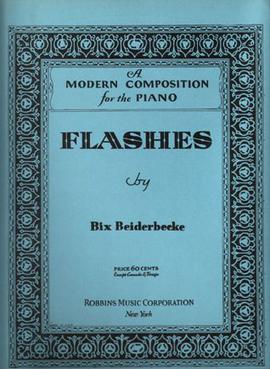
"Flashes" is a 1931 jazz composition for solo piano by cornetist Bix Beiderbecke. It is the third work in a series of four compositions for piano composed by Bix Beiderbecke during his career.

Clarinet Marmalade, later Clarinet Marmalade Blues, is a 1918 dixieland jazz standard composed by Larry Shields and Henry Ragas of the Original Dixieland Jass Band. It is played in the key of F major. It was recorded by Fletcher Henderson in 1926 and Frankie Trumbauer in 1927.

"Singin' the Blues" is a 1920 jazz composition by J. Russel Robinson, Con Conrad, Sam M. Lewis, and Joe Young. It was recorded by the Original Dixieland Jass Band in 1920 as an instrumental and released as a Victor 78 as part of a medley with "Margie". The song was released with lyrics by vocalist Aileen Stanley in 1920 on Victor. In 1927, Frank Trumbauer, Bix Beiderbecke, and Eddie Lang recorded and released the song as an Okeh 78. The Trumbauer recording is considered a jazz and pop standard, greatly contributing to Frank Trumbauer and Bix Beiderbecke's reputation and influence. It is not related to the 1956 pop song "Singing the Blues" first recorded and released by Marty Robbins in 1956.
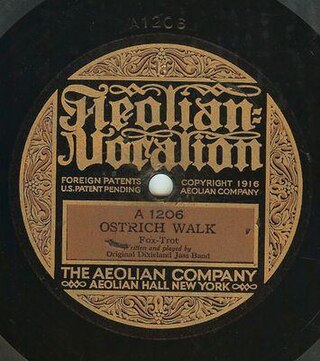
Ostrich Walk" is a 1917 jazz composition by the Original Dixieland Jass Band released as an instrumental as an Aeolian Vocalion and a Victor 78. Frankie Trumbauer and Bix Beiderbecke recorded the song in 1927. The song is a jazz milestone as one of the first commercially released "jass" or jazz recordings.

Irving "Izzy" Friedman was an American jazz reedist, best known for playing clarinet on records released by Paul Whiteman and Bix Beiderbecke in the 1920s.
Benny Meroff (1899-1973) was an American dance bandleader active in the swing jazz era. He also played violin, clarinet, and saxophone.